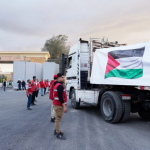
A Year in the Israel-Hamas Conflict: From Victory to Defeat for Netanyahu
October 7, 2024. In the context of the conflict that erupted in Gaza after a Hamas attack exactly a year ago, Israeli Prime Minister Benjamin Netanyahu’s leadership and strategy are being scrutinized. Several analysts expected an end to the ongoing conflict a year later. But the reality is completely different, which has deepened the crisis.
Image of ongoing conflict
After the attack by Hamas on October 7 last year, the Israeli forces began to carry out massive airstrikes in Gaza. According to Hamas, their attack was part of resistance against Israeli occupation.
But the war that followed left 70 percent of Gaza’s homes damaged and the city plunged into a humanitarian crisis. According to international human rights organizations, the death toll has exceeded 42,000 and the people of besieged Gaza are deprived of food, medical care and essential livelihoods.
Netanyahu’s strategy and goals
Netanyahu set three key goals in setting strategy for his government:
Release of prisoners: He has claimed that the release of prisoners is his main objective, which has made some progress in the implementation process.
Eliminate Hamas and other resistance groups: Netanyahu’s goal is to eliminate Hamas completely, so that they cannot rise up against Israel in the future.
Ending Iran’s nuclear program: Netanyahu considers Iran’s nuclear program a major threat and is ready to take action against it.
Hamas’ response
Hamas leader Yahya Sinwar sees the ongoing crisis as the beginning of a new struggle. He said, we will continue to fight against usurpation of our rights and to achieve them. We need to strengthen our resistance.
This position of Hamas basically adds a new dimension to the fight against Israel and the accusations of terrorism against them have faced a new challenge to the Israeli government.
Global feedback
From a global perspective, the problem of Palestine has become the focus of the human rights movement. Governments of various countries and international organizations have stood up for Palestine and are demanding sanctions against Israel. The European Union, the United Nations and other international organizations have expressed concern over the situation and called for humanitarian assistance.
Hamas fights against Netanyahu’s plans
Netanyahu’s strategy may be temporarily successful. But Hamas, led by Sinwar, is building a long-term resistance. Sinwar has been able to garner support for resistance to Israeli occupation, which has strengthened Hamas’s position. If Sinwar achieves his goal, Israel may be forced to return the territory it has occupied.
After the conflict of the past one year, the national problem of Palestine has been reawakened. Netanyahu’s war strategy has destabilized the entire region.
This new phase of the Israeli-Palestinian conflict has raised many questions about the future. Where not only military power but also diplomatic space is becoming important.
This image of conflict is redefining the political and social reality of the Middle East. The conflict has attracted the attention of the international community. It also showed that the time has come for new strategies and initiatives for the Middle East peace process.
Source: Middle East Eye






![Pakistan accuses the TTP of carrying out attacks on its territory and the Afghan Taliban government of harbouring the group [File: Fayaz Aziz/Reuters]](https://asiandiplomacy.com/wp-content/uploads/2025/10/2023-02-27T041341Z_1777986366_RC2O7Z9GI1FB_RTRMADP_3_PAKISTAN-BLAST-POLICE-1760256429-150x150.webp)